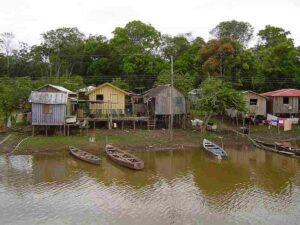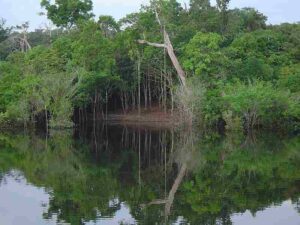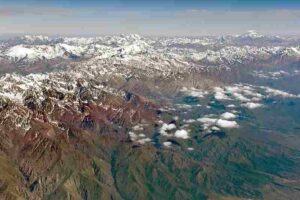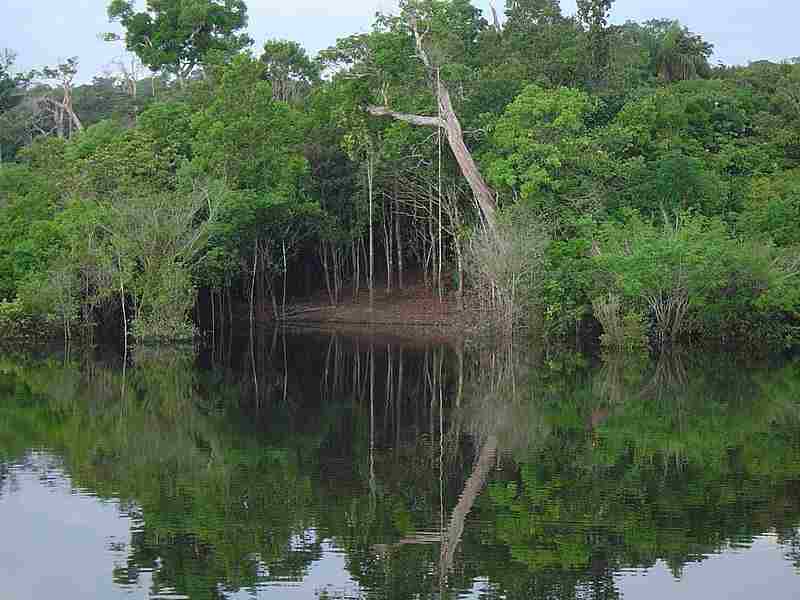7 Importance of The Amazon River Discussed
The importance of the Amazon River is a product of its involvement in freshwater reservation, biodiversity sustenance, climatic regulation, carbon sequestration, nutrient cycling, sociocultural symbolism, and ecotourism.
This article discusses the importance of the Amazon River,, as follows;
1). Freshwater Reservation
Freshwater reservation, by the Amazon River, is a function that shows the importance of this aquatic ecosystem. Here, some areas of relevance of freshwater and its reservation in the Amazon, are highlighted and summarily discussed.
Relevance of Freshwater In the Amazon River
As a freshwater reserve, the Amazon River performs various functions and supports processes like biodiversity support, drinking water supply, irrigation, transportation, hydroelectricity generation, aquaculture, climate regulation, carbon storage, and scientific research.
Some of these are also discussed as separate reasons for the importance of the Amazon River in this article. They are outlined below.
The Amazon River basin is one of the most biodiverse regions on Earth. Its freshwater ecosystems provide essential habitats for numerous species of fish, amphibians, reptiles, and aquatic mammals. These ecosystems are critical for maintaining species richness and biodiversity both within the river and in the surrounding rainforest.
Millions of people who live within and around the Amazon basin depend on the river as a primary source of drinking water. Access to clean freshwater from the Amazon is essential for human survival and public health.

The river's waters are used for irrigation purposes in agriculture. Farmers along the river and its tributaries utilize the water for growing crops such as rice, maize, and sugarcane, which helps combat food insecurity in the region.
The Amazon River serves as a vital transportation route for both local communities and commercial activities. It facilitates the movement of people, goods, and resources, connecting remote areas with urban centers.
Also, the river's flow and energy potential make it suitable for power generation, as a hydroenergy system. Water dams and hydroelectric power stations along the Amazon and its tributaries provide electricity to the region, supporting economic development.
The Amazon River and its tributaries are home to a highly diverse range of fish species, many of which are harvested for food. Fishing is a crucial means of livelihood for many communities, as it provides a source of income and protein.
Various economic activities are supported by the river, including ecotourism, timber production, and mining. The availability of freshwater is essential for these industries to thrive sustainably.
The Amazon River and its vast basin are vital in regional and global climate regulation. The river's water cycle helps maintain rainfall patterns, influencing weather systems and contributing to temperature regulation. Wetlands and floodplains along the river store significant amounts of carbon, thereby helping to mitigate climate change. Conserving these areas is an important step for maintaining global carbon sequestration.
As a freshwater source, another attribute of the Amazon River is its immense cultural and social significance for the indigenous peoples and local communities that have lived along its banks for generations. It is central to their way of life, traditions, as well as spiritual beliefs.
The Amazon River basin provides a unique and invaluable natural laboratory for scientific research. Scientists study its ecosystems, biodiversity, and hydrology to better understand complex ecological processes and inform conservation efforts.
Ecological services and influence of the Amazon River basin, extend far beyond its immediate region. It contributes to global ecosystem services such as oxygen cycling (and production), carbon storage, and climate regulation on a large scale, making it a critical component of the Earth's environmental system.
2). Sustenance of Aquatic Species
The Amazon River can be credited with providing sustenance for a large and diverse population of aquatic species. This section addresses its role in this regard, as well as some related issues.
The Amazon River as a Host to Diverse Aquatic Populations
Issues that can be discussed with regards to biodiversity in the Amazon River include; contribution to food security, local livelihood, cultural significance, aquaculture potential, research and conservation, ecosystem services, tourism and recreation, genetic resources, and global ecological impact. They are outlined below.
The Amazon River and its vast basin serve as hosts to an array of aquatic organic groups, including fish, amphibians, reptiles, and some mammals. This region is considered one of the most biodiverse on the planet, with thousands of species, several of which are endemic and occur nowhere else in the world.
Aquatic species from the Amazon River are a critical source of food for millions of people living in the region. Fish, derived from the river, is a staple in the diets of many Amazonian communities. The sustainable harvest of aquatic species helps ensure food security by providing a source of protein for local populations.
Fisheries that occur in the Amazon River basin support numerous livelihoods. Many communities rely on fishing as a primary source of income, so that it provides economic opportunities for people in remote and often economically marginalized areas.
Indigenous peoples and local communities that live along the Amazon River have deep cultural connections to aquatic species. These species are central to their traditional diets, as well as some of their beliefs and customs. The sustenance of aquatic life is therefore integral to their way of life.
The Amazon River and its tributaries offer favorable conditions for freshwater aquaculture, which can be an environmentally sustainable way to produce fish for both local consumption and commercial markets. Managed aquaculture can help to reduce pressure on wild fish populations, while also supporting the local economy.
Diverse aquatic ecosystems of the Amazon River basin and their native floral/faunal populations, provide a rich context for scientific research. Some scientists study these habitats to better understand species interactions, evolution, behavior, and adaptation.
Also, some Amazon River species may hold genetic traits that are valuable for breeding programs and research. These traits can potentially be used to enhance aquaculture and conservation efforts.
Aquatic species in the Amazon River basin are very instrumental in maintaining the health of the entire ecosystem. They constitute part of complex food webs, help to regulate biogeochemical cycles, and contribute to the equilibrium of the ecosystem.
The vast biodiversity of the Amazon River and its aquatic life makes it a popular destination for ecotourism and recreational activities such as fishing and wildlife watching. This tourism in turn contributes to the regional economy.
Interconnections exist between the Amazon River basin and global ecosystems. This is because its biotic and abiotic components contribute to global processes like nutrient recycling and carbon sequestration. The conservation of Amazonian aquatic biodiversity has implications for global ecological balance and climate regulation.
Lastly, the Amazon River and its aquatic species are invaluable for educational purposes. They serve as viable subjects for scientific study and environmental education, which can be used to raise awareness about the importance of biodiversity and the need for conservation.
3). Climatic Influence
Climatic influence is an attribute and function of the Amazon River (basin), as it exerts significant impacts on regional and global climate patterns. Issues that can be discussed in relation to the climatic influence of the Amazon River are extensive and multifaceted. Some are addressed in the subsection below.
Aspects of the Climate-Influencing Function, of the Amazon River Basin
Climatic influence of the Amazon River basin can be discussed and understood on the basis of concepts like climate regulation, rainfall generation, hydrological cycling, drought mitigation, flooding, carbon storage, biodiversity preservation, regional agriculture, navigation and transport, scientific research, tourism and recreation.
The Amazon River basin, with its vast forests and water bodies, acts as a natural climate regulator. This is because the dense vegetation and large water surfaces can absorb and release thermal energy/heat, thereby helping to stabilize temperature extremes and maintain a relatively consistent climate in the region.
Processes of transpiration, where plants release water vapor through their leaves, are prolific in the Amazon Rainforest. This moisture is carried by prevailing winds, and contributes to rainfall patterns not only in the Amazon basin but also in adjacent regions, including some parts of South America.
Global water cycles are supported by processes that occur in the Amazon River basin. The vast volume of water transported by the river, along with the release of moisture through evapotranspiration, contributes to the replenishment of atmospheric moisture. This moisture, which occurs in the form of water vapor, is transported by atmospheric circulation patterns and eventually falls as precipitation in distant regions around the world.
Also, the Amazon River helps mitigate the impacts of both droughts and floods. During periods of heavy rainfall, the river and its extensive wetlands can absorb excess water, thereby reducing the risk of catastrophic downstream flooding. On the other hand, during dry seasons, the stored water can help to maintain minimum flow levels, thereby ensuring a reliable supply of water for surrounding communities and natural habitats.

Another important factor to note is that the Amazon Rainforest is an effective carbon sink, which sequesters large amounts of carbon dioxide (CO2) from the atmosphere. This carbon storage helps to mitigate the effects of global warming. The river's influence on the rainforest's sustainability and vitality, indirectly contributes to carbon storage.
Ample water supply and stable climate which are provided by the Amazon River and rainforest, support a diverse group of plant and animal species. The conservation of this biodiversity is in turn essential for ecosystem stability and resilience in the face of environmental issues or stressors like climate change.
Along with its surrounding floodplains, the Amazon River is used for agriculture and livestock grazing. The river's water resources are central to sustaining these activities, which are themselves necessary for regional food security.
Climatic influence of the Amazon River is a relevant subject of scientific study. Researchers monitor climate patterns, rainfall, and temperature variations in the area, to better understand the river's role in regional and global climate systems.
Lastly, the Amazon River's distinctive climatic conditions and aesthetic appeal, make it a popular destination for ecotourism.
4). Carbon Sequestration
Carbon sequestration is a notable aspect of the Amazon River's importance, and is closely tied to the role of climate change mitigation.
Aspects of Carbon Sequestration by the Amazon River
Carbon sequestration by the Amazon River can be discussed with reference to factors such as climate change mitigation, resilience, biodiversity tolerance, global carbon balance, forest health, regional and ecosystem services, scientific research, and international agreements. Below is an outline that summarizes these points.
The Amazon Rainforest which is supported by the Amazon River and its tributaries, is among the largest and most effective carbon sinks on the planet. It stores relatively-large amounts of carbon dioxide (CO2) that are absorbed from the atmosphere during the process of photosynthesis. Trees in the rainforest capture carbon in the process of their growth, and stored it away in their biomass.
Carbon sequestration within the Amazon River basin, contributes immensely to the mitigation of climate change on various scales. By removing CO2 from the atmosphere, the rainforest helps to reduce the concentration of greenhouse gases responsible for global warming. This function helps the Earth's climate by offsetting some emissions from human activities such as fossil fuel burning.
Stored carbon in Amazonian trees and soil, provides resilience to the impacts of climate change. As global temperatures rise, the Amazon Rainforest's ability to sequester carbon becomes increasingly important. It helps regulate temperature and moisture levels within the rainforest by minimizing warming rates/severity, and supports the adaptation of both local ecosystems and indigenous communities to these changing conditions.
The carbon-rich environment of the Amazon Rainforest is known to support a diverse population of plant and animal organisms. These species, in turn, contribute to the ecosystem's continuity and resilience.
As a carbon sink, the role of the Amazon River basin has a global reach. It helps to balance the global carbon budget by removing some CO2 from the atmosphere. The carbon stored in the basin remains locked away for extended periods, thereby contributing to long-term carbon storage.
It must be noted that the ability of the Amazon Rainforest to sequester carbon is closely linked to its vitality. When the forest is intact and thriving, it can capture and store carbon effectively. However, activities such as deforestation, and land conversion (through agriculture and urbanization) can release stored carbon back into the atmosphere, causing the ecosystem to act as a carbon source, and exacerbating climate change.
Carbon sequestration capacity of the Amazon River basin is linked to multiple ecosystem services that benefit both the region and the world. These services include water purification, improvement of air quality, and soil conservation. In addition, carbon-rich forests contribute to the regulation of regional and global climatic patterns.
Like other of its functions, researchers study carbon sequestration in the Amazon River basin to better understand its role in the global carbon cycle and climatic trends. These studies inform climate models and policies aimed at mitigating environmental degradation.
As portrayed so far, the importance of carbon sequestration in the Amazon River basin has led to international efforts to protect and conserve the rainforest. Treaties such as the Paris Agreement recognize the significance of rainforest preservation in mitigating climate change.
5). Nutrient Cycling
Nutrient cycling is a fundamental ecological process which benefits from the Amazon River in diverse ways that are addressed here.
How the Amazon River is Linked to Regional Nutrient Cycling
Links between the Amazon River and the process of nutrient cycling can be identified in various areas including biodiversity, carbon sequestration, and climate regulation.
Nutrient cycling is driven by the river's flow and interactions with the surrounding rainforest, and supports the growth of dense vegetation as well as diverse plant and animal species. The cycling of essential nutrients like nitrogen, phosphorus, and potassium is a critical function for maintaining the rainforest's high levels of productivity.
This implies that the health of the surrounding rainforest depends on nutrient cycling in the Amazon River basin. Rainforests typically have nutrient-poor soils (affected by weathering, leaching and erosion), and the regular flooding of the Amazon River brings in sediments rich in organic matter and nutrients from the Andes Mountains. These nutrient inputs replenish the soil, supporting the growth of trees and other vegetation. Such processes ensure that the rainforest remains resilient and can recover from natural disturbances like flooding and droughts.

Cycling of nutrients contributes to the Amazon Rainforest's biodiversity. A broad variety of plants and animals have evolved to rely on the nutrient-supply created by the river's periodic flooding. This biodiversity, in turn, supports ecosystem stability.
As stated earlier, the Amazon River and its tributaries are inhabited by a diverse array of fish species. Nutrient cycling in the river sustains the growth of phytoplankton and aquatic plants, which forms the base of the aquatic food chain. Indigenous communities depend on these fisheries for their livelihoods..
The nutrient-rich sediments transported by the Amazon River, contribute to the fertility of floodplain soils. These fertile soils are in turn used by local communities for agriculture, including the cultivation of crops like rice, maize, and cassava. Nutrient cycling ensures the long-term sustainability of these agricultural practices.
Also, nutrient cycling is closely linked to carbon cycling. The uptake of carbon dioxide (CO2) by plants during photosynthesis is only possible with the availability of essential nutrients. Efficient cycling of nutrients in the Amazon basin enhances carbon sequestration, and helps to mitigate climate change by removing CO2 from the atmosphere.
The Amazon River basin's nutrient cycling function can also be linked to climate regulation. Release of volatile organic compounds (VOCs) by rainforest vegetation, influenced by nutrient availability, can affect both cloud formation and rainfall patterns. This, in turn, has implications for local and global climate systems.
Nutrient cycling in the Amazon River also helps to maintain regional water quality. The efficient uptake of nutrients by plants and algae can prevent excessive nutrient runoff into water bodies, which can lead to water pollution/eutrophication and harmful algal blooms.
Lastly, the Amazon River and its nutrient cycling processes have been useful as subjects of extensive scientific research. Understanding these processes is important for management and conservation of the rainforest, mitigation of climate change, and sustainability of the region's habitats and resources.
6). Sociocultural Symbolism
Sociocultural symbolism of the Amazon River, reflects its importance in the lives of the people and cultures residing within the Amazon basin and its environs.
Analyzing the Sociocultural Symbolism of the Amazon River
Factors that point to the sociocultural relevance of the Amazon River include; cultural identity, spiritual/religious significance; art and craftsmanship, oral traditions, traditional knowledge, local festivals, and tourism. These are simplified in the following outline;
The Amazon River is central to the cultural identity of many indigenous communities living along its banks. It has been a source of spiritual inspiration and cultural significance for these communities for generations. The river is sometimes personified and considered a living entity; a mother, and a giver of life.
This implies that the Amazon River and its tributaries are integral to the spiritual and religious beliefs of indigenous peoples. Several rituals, ceremonies, and myths revolve around the river, its origin, inhabitants, and its connection to the supernatural. It is often portrayed as a bridge between the earthly and spiritual realms.
Indigenous art, crafts, and textiles frequently feature motifs inspired by the Amazon River and its wildlife. These symbols are not just artistic expressions, but also convey cultural traditions and stories. They are used in the creation of pottery, baskets, clothing, and jewelry.
The Amazon River has a prominent contribution to the oral traditions of indigenous groups. Stories, songs, and legends are passed down through generations, recounting the history, mythology, and experiences of communities living along the river. These narratives help to preserve cultural heritage.
Indigenous communities have a deep understanding of the Amazon River's habitats, plants, and animals. This traditional ecological knowledge is essential for their survival and is often intertwined with cultural practices and beliefs.
In the same vein, many festivals and celebrations in Amazonian cultures are tied to the rhythms of the river and its natural cycles. These events include rituals related to planting and harvesting, as well as celebrations that honor the river's abundance, and the spirits believed to inhabit it.
Indigenous languages of the Amazon often contain words and phrases related to the river and its surroundings. These linguistic elements are not only descriptive but also carry cultural meanings and stories about the relationship between people and the river.
Traditional riverine communities rely on the Amazon River for transportation and trade. They possess extensive knowledge of the river's currents, channel morphology, and navigational techniques. This practical knowledge is vital for their daily lives, and has cultural significance.
The cultural symbolism associated with the Amazon River attracts eco-tourists and cultural tourists from around the world. Visitors are drawn to indigenous communities to learn about their way of life, traditions, and spiritual connection to the river.
It has gained global recognition and has become a focal point for discussions about indigenous rights, environmental conservation, and the protection of cultural diversity. It has raised awareness about the importance of preserving both the natural and cultural heritage of the Amazon basin.
7). Ecotourism Value
Ecotourism value is an area of importance of the Amazon River, both in terms of sustaining the region's ecosystems and providing economic opportunities for local communities.
Overview of the Ecotourism Value of the Amazon River
The ecotourism value of the Amazon River and Rainforest, is linked to biodiversity and wildlife observation, conservation and awareness, economic opportunities, cultural exchange, and support or protected areas, among other concepts. These are outlined below.
Ecotourism allows visitors to experience the immense biodiversity of the Amazon firsthand. Tourists can observe diverse wildlife, including jaguars, monkeys, exotic birds, and unique fish species in their natural habitats along the riverbanks and tributaries.
It also fosters a sense of responsibility and stewardship toward the environment. Visitors gain a deeper understanding of the Amazon's ecological importance, and the need for its conservation. This heightened awareness can lead to support for conservation initiatives and policies to protect the river and its surroundings.
Income is generated through ecotourism, for local communities living near the Amazon River. Indigenous people and local guides often offer tours and accommodations, as well as handicrafts, to tourists. This provides an alternative source of income, and can reduce the pressure on traditional activities like logging and mining, which can harm the environment.
Ecotourism facilitates cultural exchange between visitors and indigenous communities. Tourists can learn about the rich cultures, traditions, and ways of life of Amazonian peoples. This exchange of knowledge and experiences can help preserve indigenous cultures while promoting mutual respect and understanding.
The Amazon River offers opportunities for adventure tourism, including kayaking and canoeing. These activities attract adventure seekers from around the world, boosting local tourism businesses and creating job opportunities.
Many ecotourism initiatives in the Amazon are community-based, which implies that local residents actively participate in and benefit from tourism activities. This model ensures that revenue stays within the community, contributing to improved living standards and infrastructure.
The revenue generated from ecotourism can be reinvested in the maintenance and protection of national parks and protected areas along the Amazon River. This financial support helps combat illegal logging, mining, and poaching among other threats to the region.
Lastly, ecotourists often become ambassadors for the Amazon. They return home with a greater appreciation for the region's natural beauty and cultural diversity, sharing their experiences and advocating for its protection on a global scale.
*Why It is Important to Protect the Amazon River
It is important to protect the Amazon River due to its ecological and socioeconomic functions including; freshwater reservation, biodiversity sustenance, climate regulation, carbon storage, nutrient cycling, sociocultural symbolism and ecotourism value. These are the sane functions that have been discussed in this article so far. An outline reiterating them is given as follows;
The Amazon River serves as a massive freshwater reservoir, which supplies water to millions of people and numerous ecosystems downstream. Protecting it ensures a stable supply of freshwater for drinking, agriculture, and industry.
Also, the river is home to a diverse array of aquatic species, some of which are found nowhere else on Earth.
Protecting the river helps maintain the rainforest's ability to absorb carbon dioxide, release oxygen, and influence regional and global climate patterns.
Amazon River's annual flood cycle replenishes nutrients in the rainforest soils, enhancing the productivity of plants and supporting the entire food chain. Protecting the river ensures the continuity of this vital nutrient cycling process.
Immense cultural and spiritual significance for indigenous communities can be attributes to the Amazon River. Preserving it is essential for respecting the heritage, traditions, and identities of these communities.
The river's ecotourism potential provides economic opportunities for local communities while fostering environmental awareness. Protecting the river sustains this valuable source of income and educates the world about the Amazon's importance.
*Why the Amazon is Important
The Amazon Rainforest is important because of its ecosystem services and resources such as; food, water, timber, mineral deposits, natural medicines, oxygen, tourist destinations, local economic opportunities, scientific information, and climate stabilization.
A wide variety of edible plants, fruits, and nuts are provided by the Amazon Rainforest, which support local diets and contribute to global food security.
The Amazon River and its tributaries supply freshwater to large populations, serving as a vital source for drinking water, agriculture, and industry.
Also, the rainforest yields valuable timber resources, thereby sustaining the global wood industry (while presenting challenges for sustainable logging practices).
Rich in minerals, the Amazon region contains significant reserves like gold, iron ore, and bauxite, driving economic development but often leading to environmental degradation.
The Amazon can be described as a pharmacy of natural medicines, with indigenous plants and traditional knowledge providing remedies for various ailments.
Photosynthesis in the rainforest produces a significant portion of the world's oxygen, vital for human and animal respiration.
Tourists are drawn to the Amazon's biodiversity and pristine landscapes, thereby supporting local economies through ecotourism and fostering conservation awareness.
The Amazon holds immense value for scientific research, offering insights into biodiversity, climate, and ecological processes with global implications.
Lastly, the rainforest plays a critical role in regulating the Earth's climate by absorbing carbon dioxide, releasing oxygen, and influencing weather patterns.
Conclusion
Importance of the Amazon Rainforest is based on its roles in;
1. Freshwater Reservation
2. Sustenance of Aquatic Species
3. Climatic Influence
4. Carbon Sequestration
5. Nutrient Cycling
6. Sociocultural Symbolism
7. Ecotourism Value



